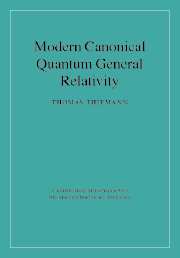Book contents
- Frontmatter
- Contents
- Foreword, by Chris Isham
- Preface
- Notation and conventions
- Introduction: Defining quantum gravity
- I CLASSICAL FOUNDATIONS, INTERPRETATION AND THE CANONICAL QUANTISATION PROGRAMME
- II FOUNDATIONS OF MODERN CANONICAL QUANTUM GENERAL RELATIVITY
- 5 Introduction
- 6 Step I: the holonomy–flux algebra P
- 7 Step II: quantum *-algebra A
- 8 Step III: representation theory of A
- 9 Step IV: (1) implementation and solution of the kinematical constraints
- 10 Step IV: (2) implementation and solution of the Hamiltonian constraint
- 11 Step V: semiclassical analysis
- III PHYSICAL APPLICATIONS
- IV MATHEMATICAL TOOLS AND THEIR CONNECTION TO PHYSICS
- References
- Index
11 - Step V: semiclassical analysis
Published online by Cambridge University Press: 04 August 2010
- Frontmatter
- Contents
- Foreword, by Chris Isham
- Preface
- Notation and conventions
- Introduction: Defining quantum gravity
- I CLASSICAL FOUNDATIONS, INTERPRETATION AND THE CANONICAL QUANTISATION PROGRAMME
- II FOUNDATIONS OF MODERN CANONICAL QUANTUM GENERAL RELATIVITY
- 5 Introduction
- 6 Step I: the holonomy–flux algebra P
- 7 Step II: quantum *-algebra A
- 8 Step III: representation theory of A
- 9 Step IV: (1) implementation and solution of the kinematical constraints
- 10 Step IV: (2) implementation and solution of the Hamiltonian constraint
- 11 Step V: semiclassical analysis
- III PHYSICAL APPLICATIONS
- IV MATHEMATICAL TOOLS AND THEIR CONNECTION TO PHYSICS
- References
- Index
Summary
Normally, when constructing a perturbative quantum field theory on Minkowski space or any other background spacetime one never doubts that the resulting theory has the correct classical limit. One is satisfied with having found a Fock representation and a definition of the S-matrix, that is, matrix elements of powers of a normal ordered Hamiltonian operator. In fact it is clear from the outset that a theory written in terms of (an infinite number of) annihilation and creation operators has the correct classical limit because one can construct the usual coherent states for the underlying free field theory and then one knows that operators written in terms of the annihilation and creation operators have expectation values very close to the classical values that the corresponding classical function takes at the point in phase space where the coherent state is peaked.
In a constrained, non-perturbative quantum field theory without background structure the question about the classical limit is much less trivial. First of all, since we are using a non-perturbative approach we cannot expand around a free field theory and hence cannot use Fock space (coherent state) techniques. Secondly, since we must work without a background spacetime we are forced to use completely new types of Hilbert spaces for which no semiclassical techniques have been developed so far. Thirdly, the theory is highly non-linear: for example, the constraint operators are simply not polynomials of the basic variables A, E for which one would hope to be able to construct semiclassical states which approximate those.
- Type
- Chapter
- Information
- Modern Canonical Quantum General Relativity , pp. 345 - 396Publisher: Cambridge University PressPrint publication year: 2007

